The Mississippi Flood: Awash In History
Note: This article documents flooding that occurred in April 2011. As of May, Prairie du Chien is once more dry and green, and all the parks and historic sites mentioned below are now open for visitors.
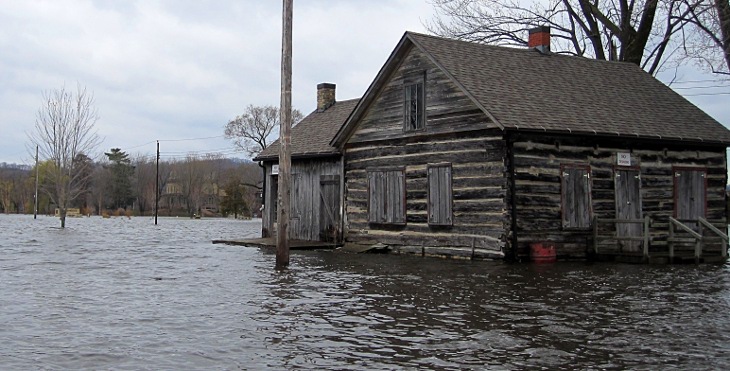
The Father of the Waters is reenacting a familiar natural drama at Prairie du Chien, Wisconsin. Swollen by spring rain and melted Minnesota snow, the Mississippi River will carry over 1.5 million gallons of water past town each second during the peak of the Flood of 2011. While the power of the river is awe inspiring, the latest flood is nothing new. At Prairie du Chien, the Mississippi is immersed in history.
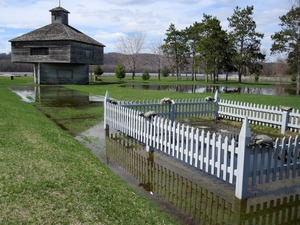
The two-story blockhouse is a replica constructed in the 1930s. The fence surrounds an excavated stone “prison pit” from the fort that has filled with water.
On April 11, 2011, floodwater began to creep across the foundations of Fort Crawford, one of Prairie du Chien’s most significant archaeological sites. Built in 1816, Fort Crawford was a federal military installation intended to secure control of the Upper Mississippi River for the United States. It was also situated on an island in the middle of a floodplain.
One year after Fort Crawford had been built, Major Stephen H. Long made an inspection of the post. “In regard to the eligibility of the site upon which Fort Crawford is erected,” wrote Long, “very little can be said in favor but much against it. … The site has been repeatedly subject to inundation, which is always to be apprehended when excessive floods prevail in the river.”
Major Long’s apprehensions proved well-founded. In 1823 he returned to Fort Crawford along with William Keating, who noted:
The river bank is here so low and flat, that by a swell which took place in the Mississippi the summer before we visited it, the water rose upon the prairie, and entered the parade, which it covered to the depth of three or four feet; it penetrated into all the officers’ and soldiers’ quarters, so as to render it necessary for the garrison to remove from the fort and encamp upon the neighboring heights, where they spent about a month. The waters having subsided, at the end of that time, they returned to their quarters; the old men about the village say that such an inundation may be expected every seven years.
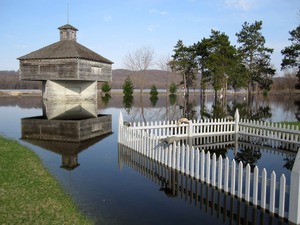
It turned out that seven years was an overestimate. In May 1826, Prairie du Chien encountered one of the worst floods in its history — and likely the first to make national news. Word traveled slowly, but on July 1, 1826, Nile’s Weekly Register of Baltimore carried a front page item stating that “the report is current here that the Mississippi has risen 14 feet and overflowed its banks at Prairie du Chien, and driven the troops from their quarters in the garrison. The consequence is that it is very sickly there.”
Henry S. Baird of Green Bay experienced the 1826 flood first hand. He was visiting that spring with James D. Doty while doing rounds for the circuit court of Michigan Territory, and more than forty years later, he vividly described his memory of the event for the Green Bay Gazette:
In May, 1826, when the term of the court was to be held at Prairie du Chien, on our arrival we found the old town entirely under water, the inundation being caused by the overflowing of both the Mississippi and Wisconsin rivers. The troops had abandoned the fort, and the inhabitants had fled to the high grounds near the bluffs — but two or three houses were occupied, and only the upper stories in those. It will naturally be imagined that under such circumstances the court could not be held. But not so — a large barn, situated on dry ground, was selected and fitted up for the accommodation of the court, bar and suitors! The court occupied the extensive threshing-floor, about fourteen by thirty-five feet. The jurors occupied the hay and grain mows on either side of the court. When the jury retired to agree upon their verdict, they were conducted by an officer to another barn or stable. Such was the condition of affairs in the early years of Wisconsin history.
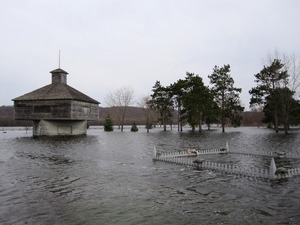
Ultimately, the inhabitants of Prairie du Chien reckoned that the Mississippi River rose 26 feet above the low water mark in 1826. There is no way to know how closely their observation corresponds with modern measurements, but it may mean that the Flood of 1826 was comparable to the disastrous Flood of 1965. The latter flood crested at 25.38 feet, the highest level known since the installation of river gauges.
At Fort Crawford, the Flood of 1826 had been devastating. Troops spent nearly the entire month of May encamped on higher ground. When they returned on May 29, they found that the bunks had been destroyed and that the floors were “uneven as may be, having been driven from place by the late freshet.” By the end of 1826, the army determined to abandon the fort, and the garrison removed to Fort Snelling near what is now St. Paul, Minnesota.
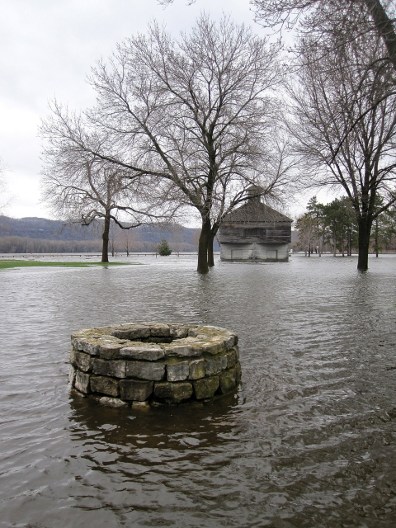
Although the military’s withdrawal from Fort Crawford was sensible in light of the recurring floods, it turned out to be a strategic mistake. In 1827, a small band of Ho-Chunk led by Red Bird attacked a farmstead at Prairie du Chien, killing two settlers. The murders sent a panic across the frontier and led the military to return — along with ten thousand feet of plank to repair the dilapidated fort. As though playing a farce, floods struck again the next year.
Finally, in 1829, the army began building a second Fort Crawford on high ground about a mile southeast of the original. Col. Zachary Taylor, later to become the 12th President of the United States, directed the new fort’s construction. One of his lieutenants was Jefferson Davis, a fresh West Point graduate assigned to oversee operations at the saw mill that provided the new fort’s lumber. Davis would go on to be President of the Confederacy during the Civil War.
Troops moved into the second Fort Crawford in December 1830, in time to avoid another significant flood in 1832. The land occupied by the first fort reverted to private ownership. By the 1840s, the fortifications had been cleared away and local entrepreneur Hercules L. Dousman had a residence constructed over the one corner of the old fort that, owing to an prehistoric Indian mound, always remained above the floodwater. Increase Lapham, an early scholar of Wisconsin’s Indian mounds, observed Dousman’s home in 1852 and wrote that “a number of very large mounds exist along the island between the slough and the river; and what is very remarkable these are on such low ground that their bases are often washed by the high water of the Mississippi. … Advantage is taken of these great embankments for the site of the better class of residences; so that they are always safe from the flood.”
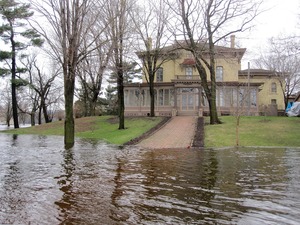
In the 1870s, the heirs of Hercules Dousman replaced his “House on the Mound” with a newer home, the Villa Louis. The Wisconsin Historical Society now maintains Villa Louis as a state historic site, and its grounds feature a reconstruction of Fort Crawford’s northwest blockhouse built exactly where its original foundations were discovered by archaeologists in the 1930s. For the historical society, facing up to high water is an inescapable part of preserving the history of Prairie du Chien.
The Flood of April 2011 will not set any records, but as the Mississippi River surrounds the Villa Louis and engulfs the first Fort Crawford foundations once again, we are reminded of the might of nature: a force that the frontier army had to fight far more frequently than Redcoats or Indians. Despite all our present day grumbling about locks and dams, climate change, and finicky computer forecasts, the Mississippi River has always flooded here — and it will flood again.

No Responses to "The Mississippi Flood: Awash In History":
Nice to see an interesting article on how the flood affected history. Hey, shoot me an e-mail sometime; I haven’t heard from you in a while. Of course, I have been slow on the draw as well.
enjoyed this article
thank you
Nice article, interesting pictures. Thanks for providing this insight to PDC area history.
Very informative article! And great pictures, gives a person a good feel of how much water comes over the banks.
Incredible photos. I know we’ve seen the devastation that the Old Miss can create but you still never get used to it. Our prayers are out to everyone affected.
why did it get flooded?
was it because of the Mississippi river?
Is it still under water?
Nice post and great photos. Makes one wonder why anything was ever built on St. Feriole Island! I do love Prairie du Chien, though, and am the author of a biography of one of its more famous 19th Century citizens, Father Lucien Galtier.
I hate that Mississippi have those terrible floods. I wish it would just stop, I love the southern look and the south . And of course you know I can’t forget about New Orleans. I love that too
my next house would be a dream house built in Mississippi. Natchez because Natchez brings out that southern look I love more than any part of Mississippi.
Mother and I drove to Praire du Chiene to see the 2014 July 4th fire works, to our surprise
No little man awaiting to take donations. It didn’t dawn on either of us that we hadn’t see any vehicals. Something glisoning caught my eye it was water,so much H20. It was on my list to this week renew my membership with the Villies historical society but I guess I will not be doing that either.